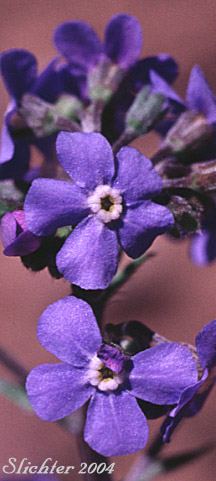

 The
photo at right shows a close-up view of the flower of blue stickseed. Photographed
at Dixie Butte, Malheur NF............July 4, 2002.
The
photo at right shows a close-up view of the flower of blue stickseed. Photographed
at Dixie Butte, Malheur NF............July 4, 2002.
Blue stickseed is a pretty perennial wildflower with several to many stems arising 30-100 cm high from a branched base atop a taproot. The herbage is typically sparsely to densely haired with spreading to reflexed or strongly downward pointing hairs. The stems range from 3-8 mm thick near their base. The basal leaves are oblanceolate to narrowly elliptic with long petioles. The basal leaves are persistent through bloom and range up to 35 cm long, including the length of the petiole, and up to 4 cm wide. The stem leaves are well developed, ranging from several to many. They are 5-20 cm long and from 7-20 mm ide. The lower stem leaves are oblanceolate in shape with petioles while the upper leaves are sessile and lance-elliptic to oblong in shape.
The inflorescence consists of numerous scropioid spikes on short branches on the upper stem. The calyxlobes are narrowly oblong-ovate in shape, 3 mm long and densely covered by short, whitish to grayish hairs. The flowers are blue with a yellow or whitish eye. The limb is 7-11 mm wide. The nutlets are 3-4.5 mm long with marginal prickles distinct to the base and 4-8 intramarginal prickles (occasionally only 1 or 2) which are much smaller than the marginal prickles.
Biennial forget-me-not: Hackelia floribunda - A biennial or short-lived perennial with 1-5 stems (usually 3 at most) from the base. The nutlets usually have no intramarginal prickles, or at most 1-2.
Blue stickseed may be found on moist to dry ground from thefoothills to fairly high elevations in the mountains. It is common in forest openings, meadows, and along streambanks.
Blue stickseed may be found east of the Cascade Mts. from southern British Columbia sout to the southern end of the Sierra Nevada Mts. of southern california and east to southwestern Alberta, central Nevada, central Utah and northwestern Colorado.